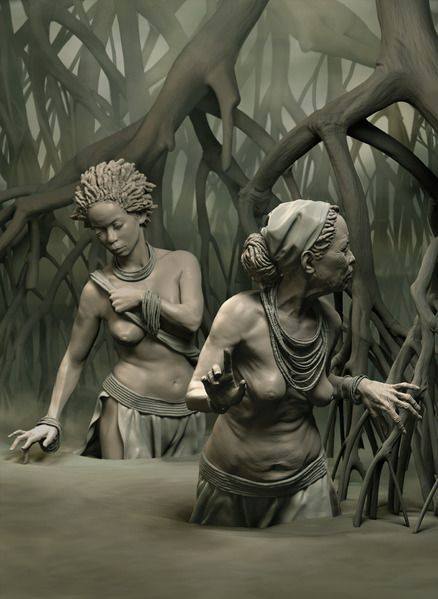 As in any mercantile system, slave agents recorded, insured, advertised, displayed, and finally, sold their “wares” to the highest bidders. To prepare for sales, dealers fed, cleaned, and oiled down slaves to hide disease and to improve appearance. Sales took place on ship decks, in slave pens, by preset contract, or at auction. On the auction block, potential buyers examined every part of these men and women’s anatomy. Healthy young men usually sold first and for the highest value.
As in any mercantile system, slave agents recorded, insured, advertised, displayed, and finally, sold their “wares” to the highest bidders. To prepare for sales, dealers fed, cleaned, and oiled down slaves to hide disease and to improve appearance. Sales took place on ship decks, in slave pens, by preset contract, or at auction. On the auction block, potential buyers examined every part of these men and women’s anatomy. Healthy young men usually sold first and for the highest value.
Printed advertisements for the sale of slaves were posted to attract buyers and often provided descriptions of available “merchandise.”
The Separation of Families
Yet Southern dealers and plantation owners defended their practices, claiming that separations of families were rare and that when they did occur, there was little hardship. South Carolinian Chancellor Harper argued that blacks lacked any capability for domestic affection and showed, “insensibility to ties of kindred.” In other words, African-Americans really didn’t mind being bought and sold since they were naturally promiscuous and lacked the ability to achieve stable family life. This, of course, was simply paternalistic racism.
How many slaves were sold away from their families? One study, Speculators and Slaves: Masters, Traders, and Slaves in the Old South by Michael Tadman, suggests that
one out of every five marriages was prematurely terminated by sale and that if other
interventions are added, the number rises to 1 in 3. In addition, slave trading tore away
one in every two slave children under the age of 14.
When the slave ship docked, the slaves would be taken off the ship and placed in a pen like this one. There they would be washed and their skin covered with grease, or sometimes tar, to make them look more healthy. This was done so that they would fetch as much money as possible. They would also be branded with a hot iron to identify them as slaves.
There were two main types of slave Auction:
1. Those that sold to the highest bidder
2. Grab and go Auctions
“Sold! to the highest bidder”
 The slaves would be brought from the pen, in turn, to stand on a raised platform so that they could be seen by the buyers. Before the bidding began, those that wished to, could come up onto the platform to inspect the slaves closely. The slaves had to endure being poked, prodded and forced to open their mouths for the buyers.
The slaves would be brought from the pen, in turn, to stand on a raised platform so that they could be seen by the buyers. Before the bidding began, those that wished to, could come up onto the platform to inspect the slaves closely. The slaves had to endure being poked, prodded and forced to open their mouths for the buyers.
The auctioneer would decide a price to start the bidding. This would be higher for fit, young slaves and lower for older, very young or sickly slaves. Potential buyers would then bid against each other. The person who bid the most would then own that slave.

























































Black woman, ooh, black woman

Light me up, troubled long….
https://twitter.com/buddhafinger/status/567765913634885632
Y’all remember this? Roots. When Kizzy Kinte was sold off and how her mother begged to no avail.
https://twitter.com/3ChicsPolitico/status/567758873408315393
https://twitter.com/3ChicsPolitico/status/567758039722123265
So cruel, heartless and demeaning!
Children separated from their mothers and fathers…families destroyed.
http://www.chipstone.org/imgpublications/2/3/39/41MB.jpg
I’m showing America the destruction she caused. I’m not going quietly into the goodnight. My ancestors are watching!
Ha! America needs to live up to that old adage. People who live in GLASS houses, shouldn’t throw STONES.